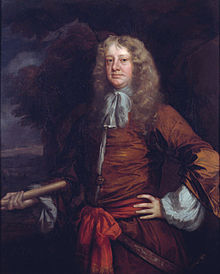George Ayscue
Sir George Ayscue (around 1616 , † 1671 ) was an English admiral who served in the English Civil War and the Anglo-Dutch naval wars.
Life
He was from Lincolnshire and was built by King I. Karl to Knight Bachelor beaten. During the Civil War in 1648, when he served as a captain in the Navy of the English Parliament , Ayscue prevented the fleet from overflowing to the Royalists, after which he was promoted to "General at Sea". In 1651 he took part in the conquest of the Scilly Isles with General at Sea Robert Blake . Later that year, he conquered Barbados and the other Caribbean islands still under the control of the royalists.
He was Governor of Barbados until he was ordered back to England in 1652 on the occasion of the First Anglo-Dutch Sea War . In August 1652 he was defeated by the Dutchman Michiel de Ruyter in the sea battle at Plymouth . After being released from his command, he served in the Swedish Navy and returned to England after the reinstatement of King Charles II .
In the Second Anglo-Dutch Sea War , Ayscue led a unit as Rear-Admiral of the Blue in the naval battle of Lowestoft in 1665. As Admiral of the White in the four-day battle in 1666, his flagship, the Prince Royal , ran aground on the third day and he surrendered and his ship to the Dutch Lieutenant-Admiral Cornelis Tromp , earning the unfortunate fame of being the highest ranking officer in the Royal Navy ever captured by the enemy. Until the end of the war in 1667 he was held in the Dutch state prison in Loevestein . He does not seem to have been in command after that and died in 1671.
literature
- Hugh Chisholm : Ayscue, Sir George . In: Encyclopædia Britannica . Volume 3, Cambridge University Press, Cambridge 1910, p. 77.
| predecessor | Office | successor |
|---|---|---|
| Francis Willoughby, 5th Baron Willoughby of Parham | Governor of Barbados 1651–1652 |
Daniel Searle (acting) |
| personal data | |
|---|---|
| SURNAME | Ayscue, George |
| BRIEF DESCRIPTION | English admiral |
| DATE OF BIRTH | around 1616 |
| DATE OF DEATH | 1671 |
